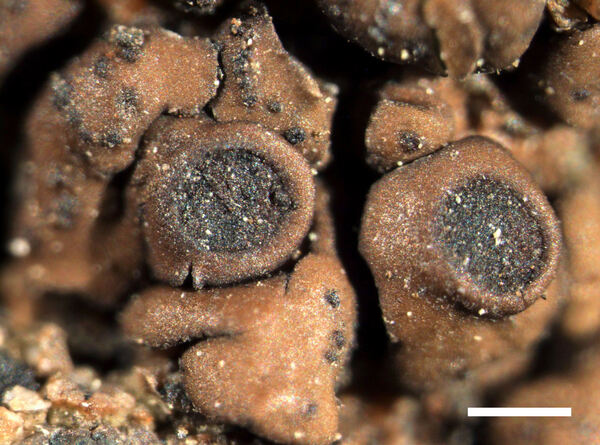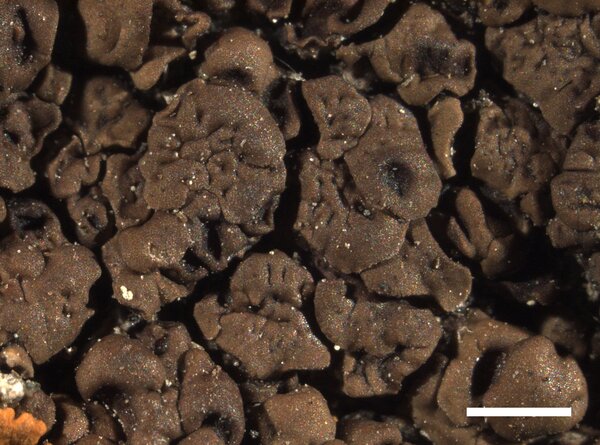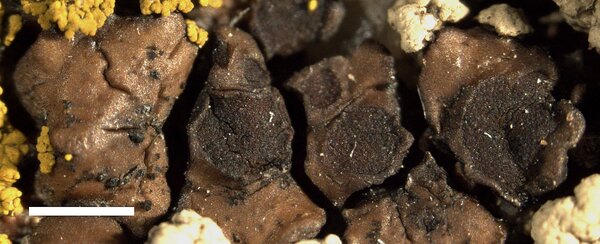Acarospora complanata H. Magn.
Svensk Bot. Tidskr., 18: 332, 1924.
Synonyms:
Distribution: N - Piem (TSB 35331). C - Tosc.
Description: Thallus crustose, episubstratic, dark brown, areolate-subsquamulose. Areoles 0,2-3 mm wide, flat to slightly convex, contiguous, with a dark brown to blackish margin and lower surface, Cortex (30-)45-100 µm thick, rich in crystals, the cells 3-4 µm wide; algal layer continuous; medulla white. Apothecia lecanorine, rounded to irregular in outline, 0.2-1 mm across, immersed in the areoles, usually 1 per areole, with a dark brown, smooth or finely rugose disc, and a raised, smooth thalline margin. Epithecium brown; hymenium colourless, (70-)80-120 µm high; paraphyses 2-2.5 µm thick at mid-level; hypothecium colourless. Asci 100-200-spored, clavate, the apical dome K/I-. Ascospores 1-celled, hyaline oblong or ellipsoid, 4-6 x 1.5-2.5 µm. Photobiont chlorococcoid. Spot tests; upper cortex and medulla K- C+ red, KC+ red, P- (reaction best visible in thick sections under the microscope). Chemistry: reported to contain gyrophoric acid, but according to Knudsen & Kocourková (2018b) the C+ and KC+ reactions are a “false positive” caused by a cortical pigment and not by gyrophoric acid. Note: this species was described from France, on basaltic rocks, and has a southern distribution in Europe, extending to North Africa; it has been also reported from North America. It belongs to a difficult complex of closely related taxa, which is in need of revision. Its ecology is poorly understood as well; the species is most frequent on base-rich siliceous rocks. See also note on A. veronensis. The records from Liguria reported by Nimis (1993, 2016) actually refer to A. crozalsii (Knudsen & al. 2024).
Growth form: Crustose
Substrata: rocks
Photobiont: green algae other than Trentepohlia
Reproductive strategy: mainly sexual
Pioneer species
Commonnes-rarity: (info)
Alpine belt: absent
Subalpine belt: absent
Oromediterranean belt: absent
Montane belt: absent
Submediterranean belt: rare
Padanian area: absent
Humid submediterranean belt: rare
Humid mediterranean belt: rare
Dry mediterranean belt: absent

Predictive model
Herbarium samples
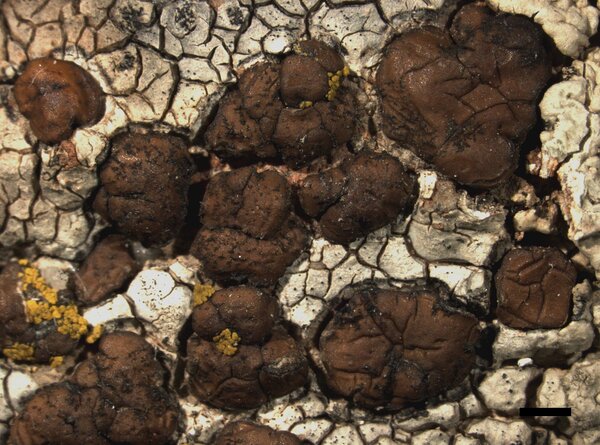

Elena Pittao; Owner: Derpartment of Life Sciences, University of Trieste CC BY-SA 4.0
Herbarium: TSB (10177)
02/02/2017
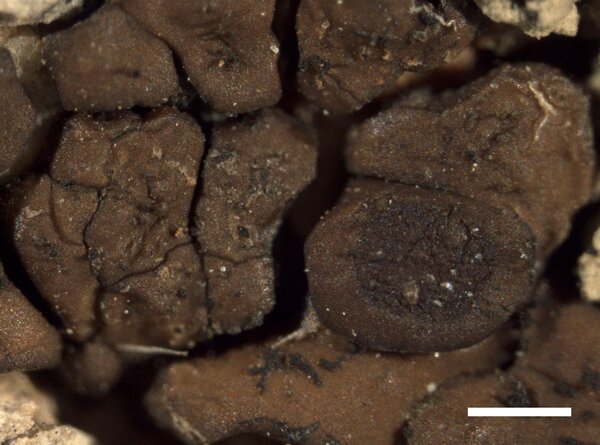

Elena Pittao; Owner: Derpartment of Life Sciences, University of Trieste CC BY-SA 4.0
Herbarium: TSB (10177)
02/02/2017
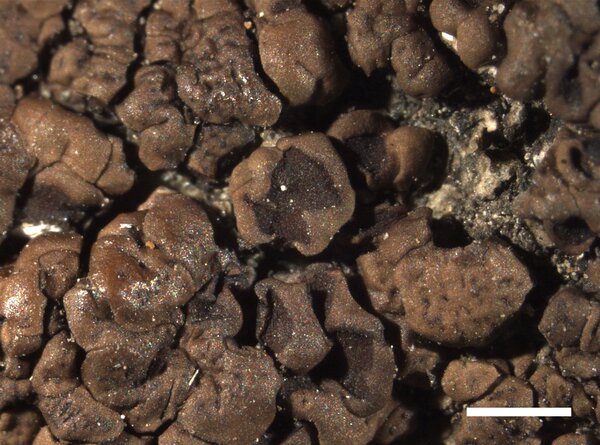

Elena Pittao; Owner: Derpartment of Life Sciences, University of Trieste CC BY-SA 4.0
Herbarium: TSB (29089)
02/02/2017
Growth form: Crustose
Substrata: rocks
Photobiont: green algae other than Trentepohlia
Reproductive strategy: mainly sexual
Pioneer species
Commonnes-rarity: (info)
Alpine belt: absent
Subalpine belt: absent
Oromediterranean belt: absent
Montane belt: absent
Submediterranean belt: rare
Padanian area: absent
Humid submediterranean belt: rare
Humid mediterranean belt: rare
Dry mediterranean belt: absent

Predictive model
| Herbarium samples |


Elena Pittao; Owner: Derpartment of Life Sciences, University of Trieste CC BY-SA 4.0
Herbarium: TSB (10177)
02/02/2017


Elena Pittao; Owner: Derpartment of Life Sciences, University of Trieste CC BY-SA 4.0
Herbarium: TSB (10177)
02/02/2017


 INDEX FUNGORUM
INDEX FUNGORUM
 GBIF
GBIF
